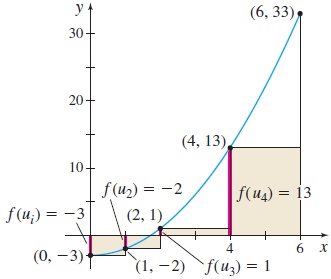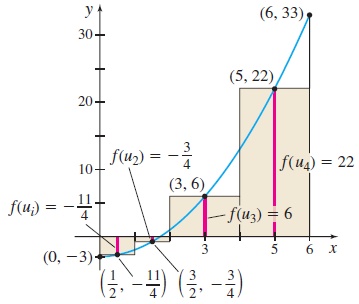EXAMPLE 1Forming Riemann Sums
For the function f(x)=x2−3, 0≤x≤6, partition the interval [0,6] into 4 subintervals [0,1], [1,2], [2,4], [4,6] and form the Riemann sum for which
- (a) ui is the left endpoint of each subinterval.
- (b) ui is the midpoint of each subinterval.

Solution In forming Riemann sums n∑i=1f(ui)Δxi, n is the number of subintervals in the partition, f(ui) is the value of f at the number ui chosen in the ith subinterval, and Δxi is the length of the ith subinterval.
(a) Figure 16 shows the graph of f, the partition of the interval [0,6] into the 4 subintervals, and values of f(ui) at the left endpoint of each subinterval, namely, f(u1)=f(0)=−3f(u2)=f(1)=−2f(u3)=f(2)=1f(u4)=f(4)=13
The 4 subintervals have length Δx1=1−0=1Δx2=2−1=1Δx3=4−2=2Δx4=6−4=2
The Riemann sum is formed by adding the products f(ui)Δxi for i=1,2,3,4. 4∑i=1f(ui)Δxi=−3⋅1+(−2)⋅1+1⋅2+13⋅2=23

(b) See Figure 17. If ui is chosen as the midpoint of each subinterval, then the value of f(ui) at the midpoint of each subinterval is f(u1)=f(12)=−114f(u2)=f(32)=−34f(u3)=f(3)=6f(u4)=f(5)=22
The Riemann sum formed by adding the products f(ui)Δxi for i=1,2,3,4 is 4∑i=1f(ui)Δxi=−114⋅1+(−34)⋅1+6⋅2+22⋅2=1052=52.5